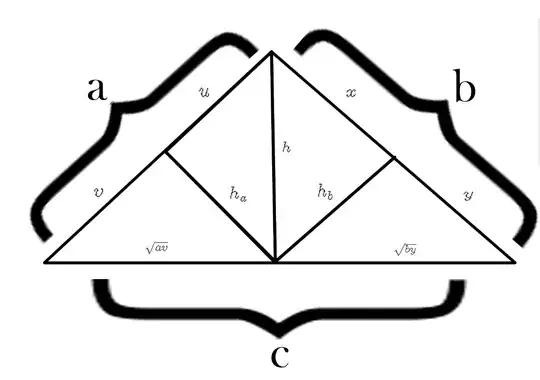A triangle with side lengths $a, b, c$ an altitude($h$), where the height($h_a$) intercepts the hypotenuse($a$) such that it is the sum of two side lengths, $a = u +v$ and height($h_b$) intercepts hypotenuse($b$) such that it is also the sum of two side lengths $b = x + y$, we can find a simple proof of herons formula.
Image here:
(Note that $h = \sqrt{au}$ and $h = \sqrt{bx}$, giving $au = bx$)
First the equations we have are:
$u + v = a$
$x + y = b$
$au = bx$
$\sqrt{av} + \sqrt{by} = c$
Substituting $v$ and $y$ with $u$ and $x$ for the $4$th equation:
$\sqrt{a^2 - au} + \sqrt{b^2 - bx} = c$
Then using $au = bx$ we eliminate $x$ to find $u$:
$\sqrt{a^2-au}+\sqrt{b^2-b\left(\frac{au}{b}\right)}=c$
$u = \frac{1}{4ac^2}(2a^2b^2+2a^2c^2-a^4-b^4+2b^2c^2-c^4)$
Finally, substituting this into $h = \sqrt{au}$:
$h = \sqrt{\frac{1}{4c^2}(2a^2b^2+2a^2c^2-a^4-b^4+2b^2c^2-c^4)}$
Plugging this into the area formula ($A = \frac{1}{2}ch$) gives:
$A = \frac{1}{2}c\sqrt{ \frac{1}{4c^2}(2a^2b^2+2a^2c^2-a^4-b^4+2b^2c^2-c^4)} $
$A = \sqrt{\frac{1}{16}(c^2 - (a - b)^2)(( a + b)^2 - c^2)} $
$A = \sqrt{\frac{1}{16}(a + b - c)( a + b + c)( b + c - a)(a + c - b)} $
$A = \sqrt{s(s - a)(s- b)(s- c)}$
Q.E.D.
Thoughts?
